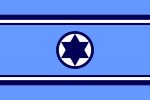Israeli Air Force
| Israeli Air Force | |
|---|---|
| Hebrew: זְרוֹעַ הָאֲוִיר וְהֶחָלָל | |
 | |
| Founded | 28 May 1948 |
| Country | |
| Type | Air force |
| Role | Aerial warfare |
| Size | 34,000 active personnel[1] 55,000 reserve personnel[2] 684 aircraft[3] |
| Part of | |
| Garrison/HQ | HaKirya Tel Aviv, Israel |
| Commanders | |
| Commander | Aluf Amikam Norkin |
| Insignia | |
| Roundel |   |
| Flag |  |
| Aviator wings |  |
| Aircraft flown | |
| Attack | Boeing F-15I Ra'am, AH-64D Saraf |
| Fighter | McDonnell Douglas F-15 Eagle, General Dynamics F-16 Fighting Falcon, Lockheed Martin F-35 Lightning II |
| Patrol | Eurocopter AS565 Panther |
| Reconnaissance | IAI Eitam, Beechcraft RC-12D |
| Trainer | Grob G-120, Beechcraft T-6 Texan II, Alenia Aermacchi M-346 Master, Beechcraft C-12 Huron, Bell 206 |
| Transport | Boeing 707-320, Lockheed C-130 Hercules, Sikorsky CH-53 Sea Stallion, Sikorsky S-70 |
| Tanker | Lockheed KC-130 Hercules, Boeing KC-707 |
The Israeli Air Force (IAF; Hebrew: זְרוֹעַ הָאֲוִיר וְהֶחָלָל, Zroa HaAvir VeHahalal, "Air and Space Arm", commonly known as חֵיל הָאֲוִיר, Kheil HaAvir, "Air Corps") operates as the aerial warfare branch of the Israel Defense Forces. It was founded on May 28, 1948, shortly after the Israeli Declaration of Independence. As of August 2017 Aluf Amikam Norkin serves as the Air Force Commander.
The Israeli Air Force was established using commandeered or donated civilian aircraft and obsolete and surplus World War II combat aircraft. Eventually, more aircraft were procured, including Boeing B-17s, Bristol Beaufighters, de Havilland Mosquitoes and P-51D Mustangs. The Israeli Air Force played an important part in Operation Kadesh, Israel's part in the 1956 Suez Crisis, dropping paratroopers at the Mitla Pass. On June 5, 1967, the first day of the Six-Day War, the Israeli Air Force performed Operation Focus, debilitating the opposing Arab air forces and attaining air supremacy for the remainder of the war. Shortly after the end of the Six-Day War, Egypt initiated the War of Attrition, and the Israeli Air Force performed repeated bombings of strategic targets deep within enemy territory. When the Yom Kippur War broke out on October 6, 1973, Egyptian and Syrian advances forced the IAF to abandon detailed plans for the destruction of enemy air defences. Forced to operate under the missile and anti-aircraft artillery threats, the close air support it provided allowed Israeli troops on the ground to stem the tide and eventually go on the offensive.
Since that war most of Israel's military aircraft have been obtained from the United States. Among these are the F-4 Phantom II, A-4 Skyhawk, F-15 Eagle and F-16 Fighting Falcon. The Israeli Air Force has also operated a number of domestically produced types such as the IAI Nesher, and later, the more advanced IAI Kfir. On June 7, 1981, eight IAF F-16A fighters covered by six F-15A jets carried out Operation Opera to destroy the Iraqi nuclear facilities at Osiraq. On June 9, 1982, the Israeli Air Force carried out Operation Mole Cricket 19, crippling the Syrian air defence array. The IAF continued to mount attacks on Hezbollah and PLO positions in south Lebanon. On October 1, 1985, In response to a PLO terrorist attack which murdered three Israeli civilians in Cyprus, the Israeli air force carried out Operation Wooden Leg. The strike involved the bombing of PLO Headquarters in Tunis, by F-15 Eagles. In 1991, the IAF carried out Operation Solomon which brought Ethiopian Jews to Israel. In 1993 and 1996, the IAF participated in Operation Accountability and Operation Grapes of Wrath, respectively. It took part in many missions since, including during the 2006 Lebanon War, Operation Cast Lead, Operation Pillar of Cloud and Operation Protective Edge. On September 6, 2007, the Israeli Air Force successfully bombed an alleged Syrian nuclear reactor in Operation Orchard.